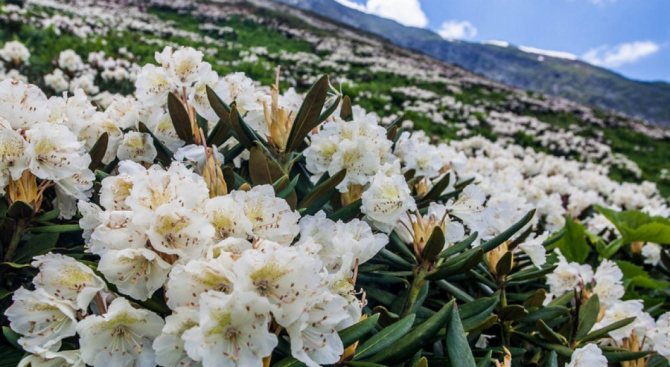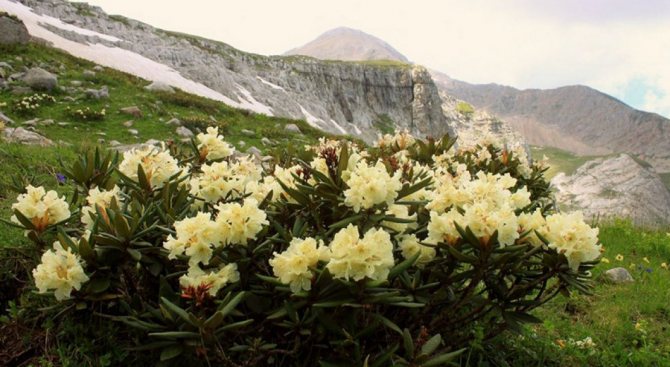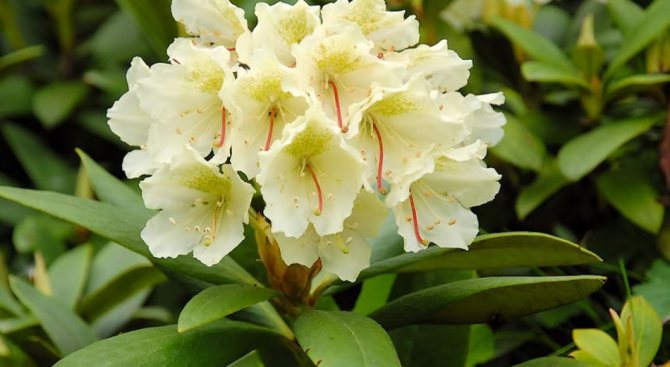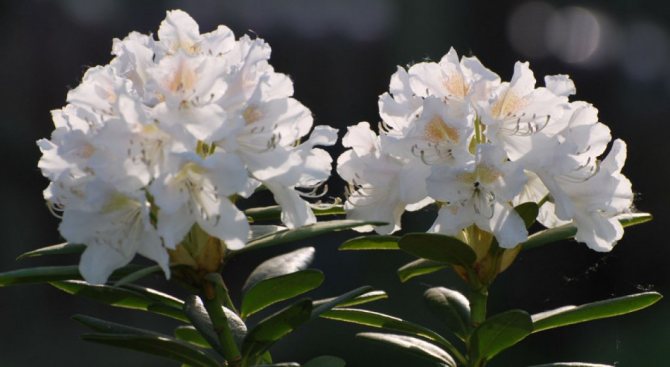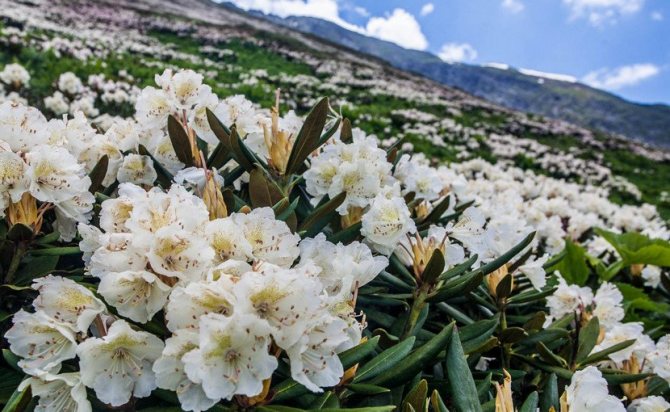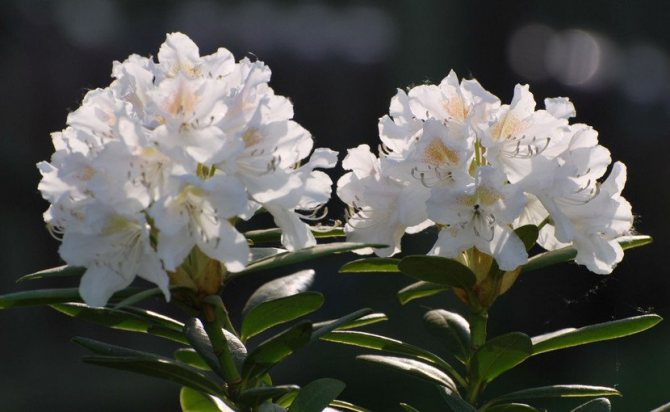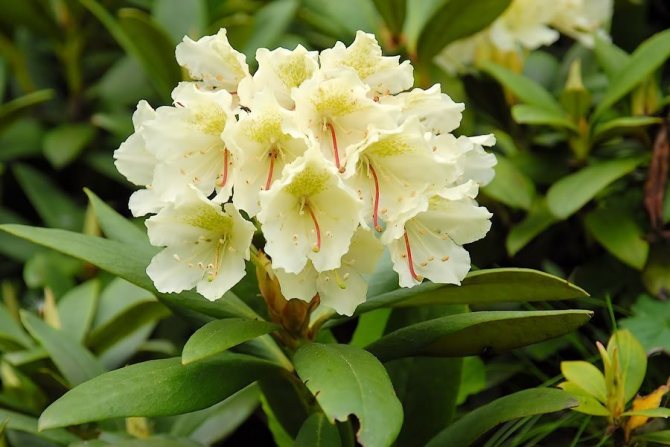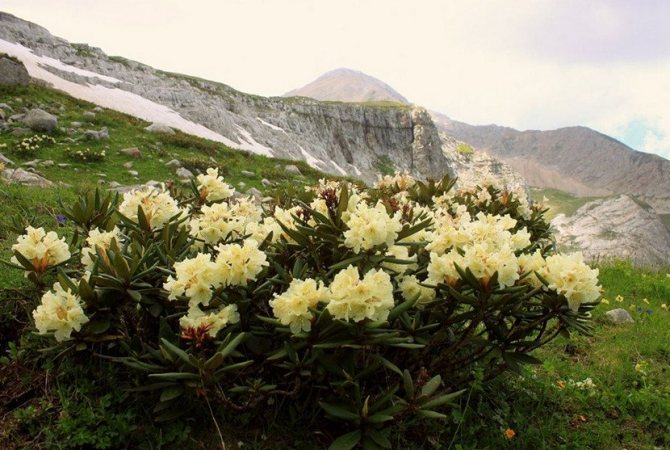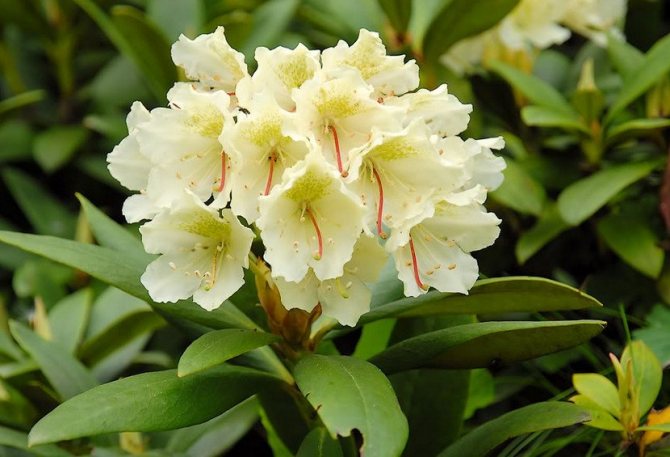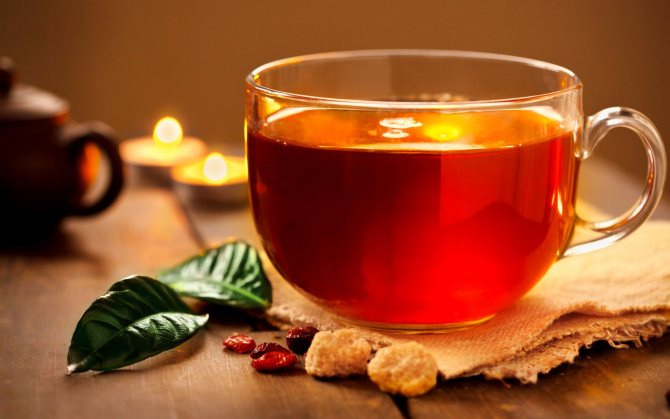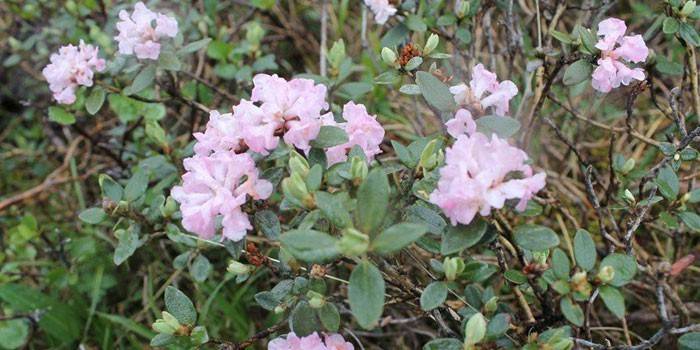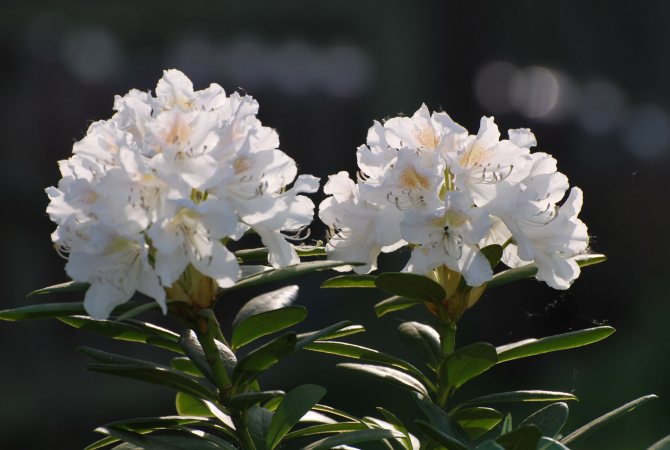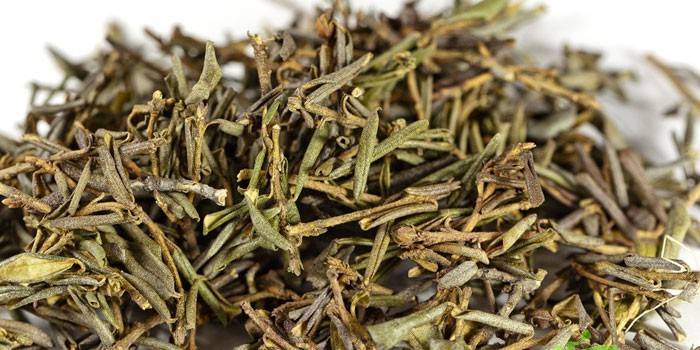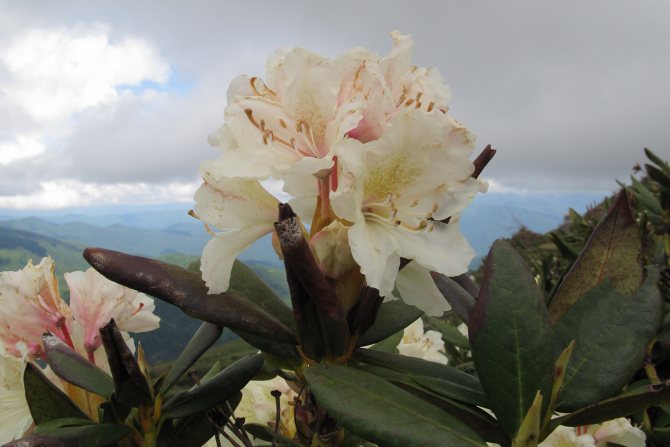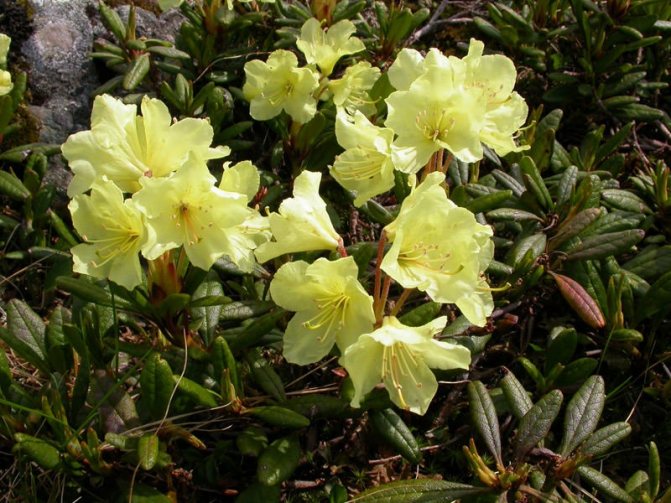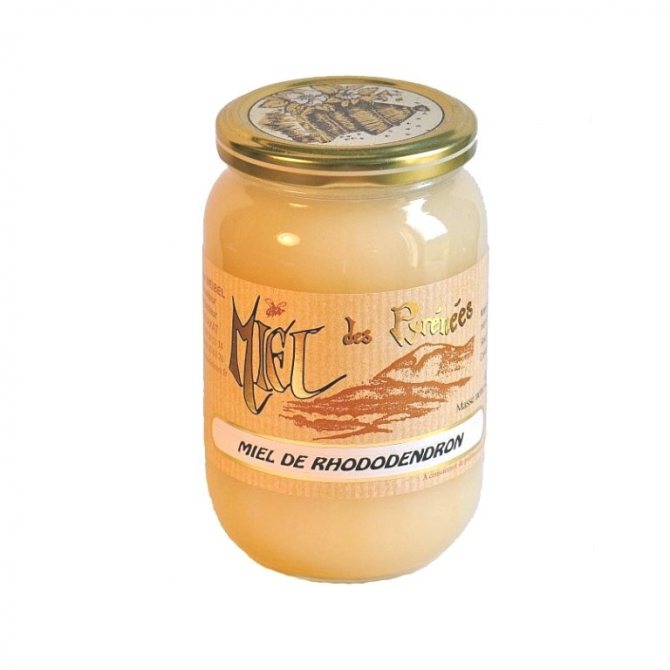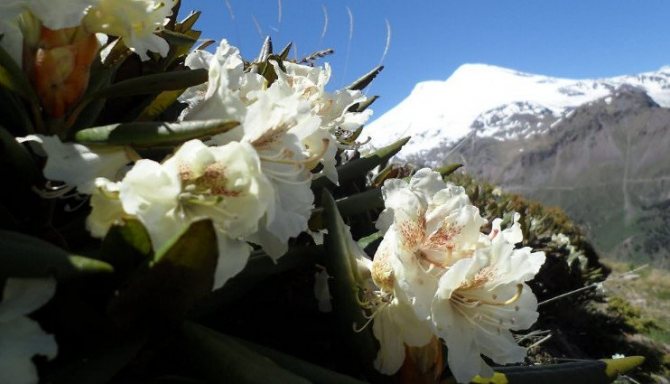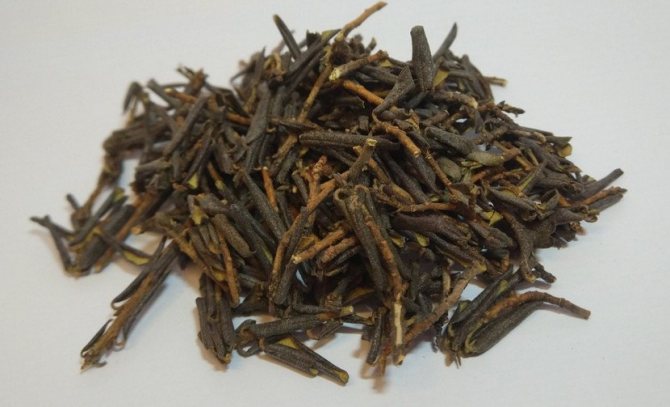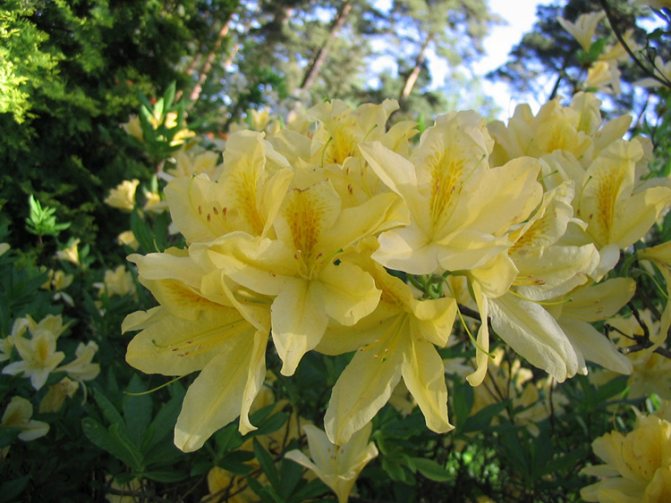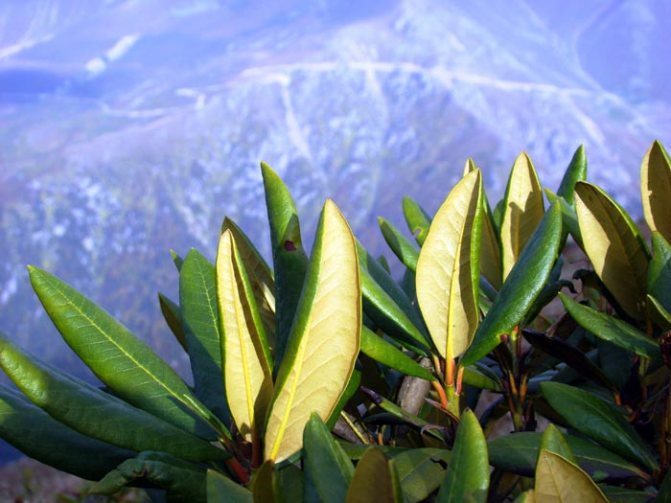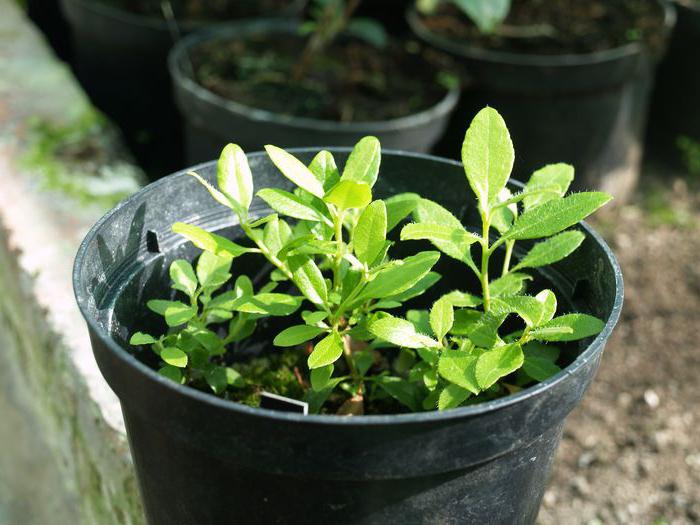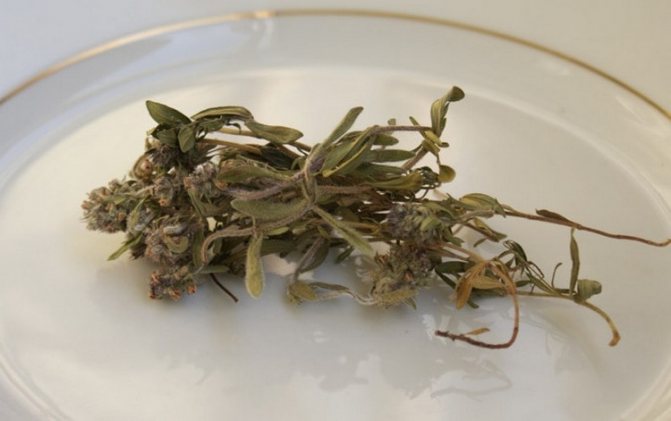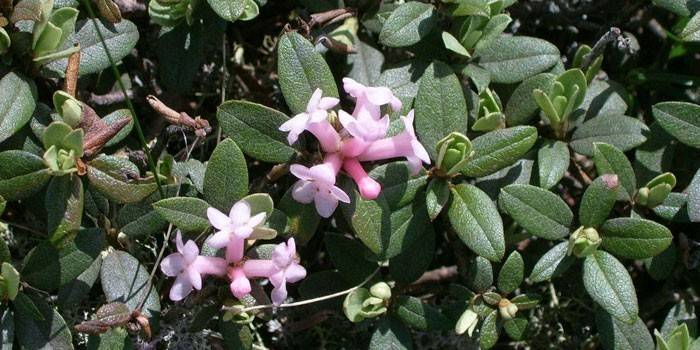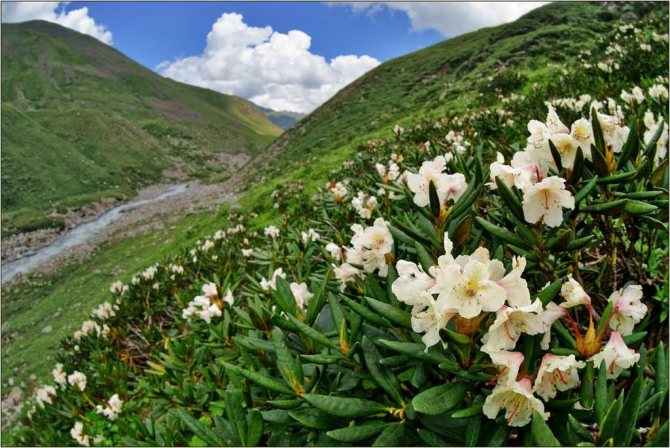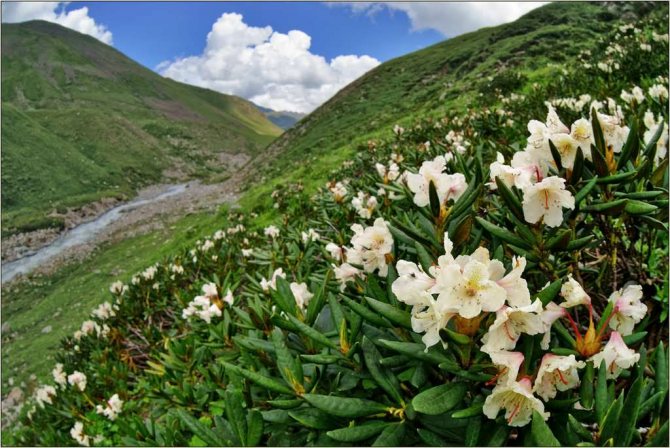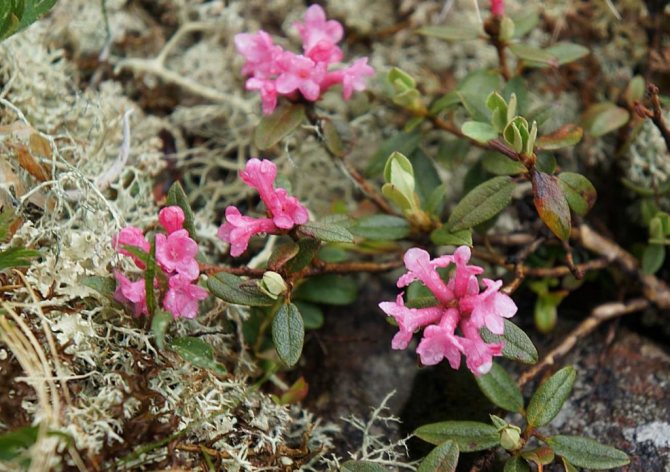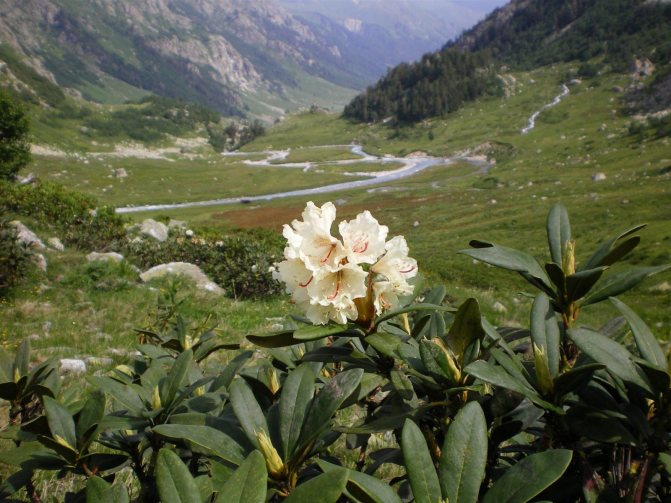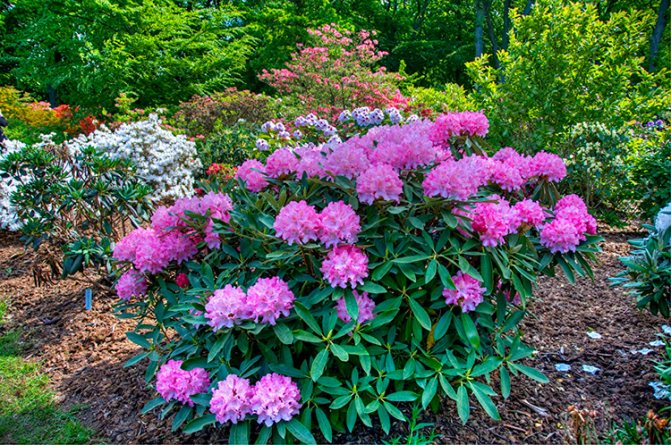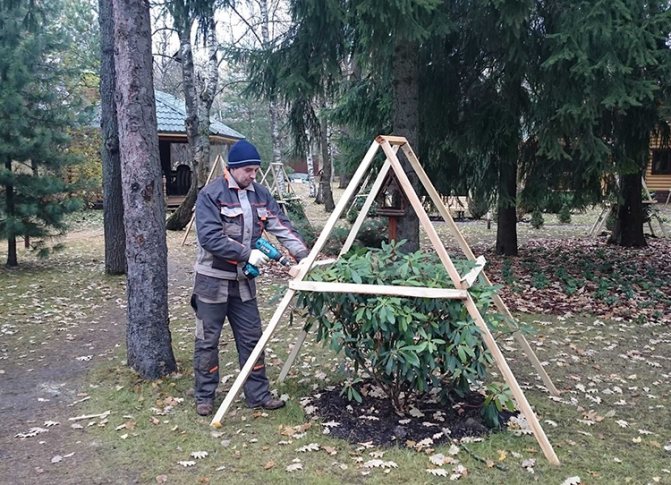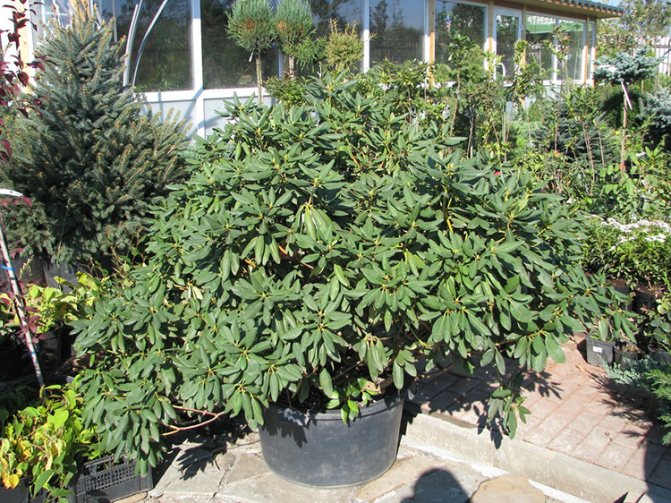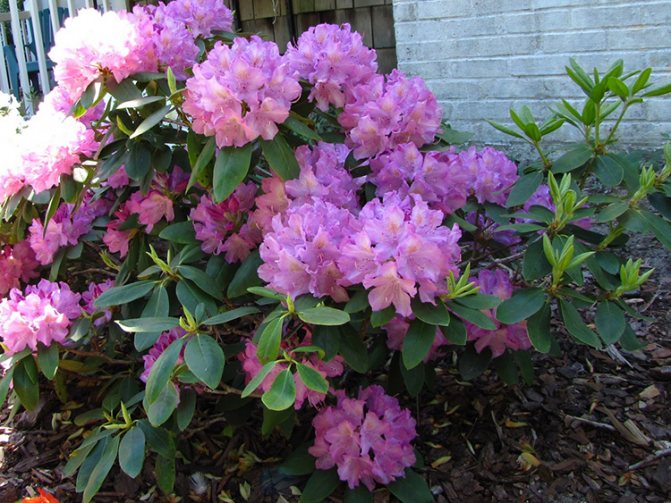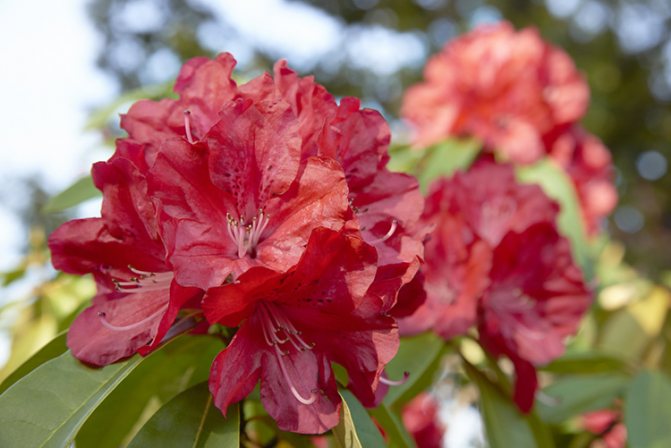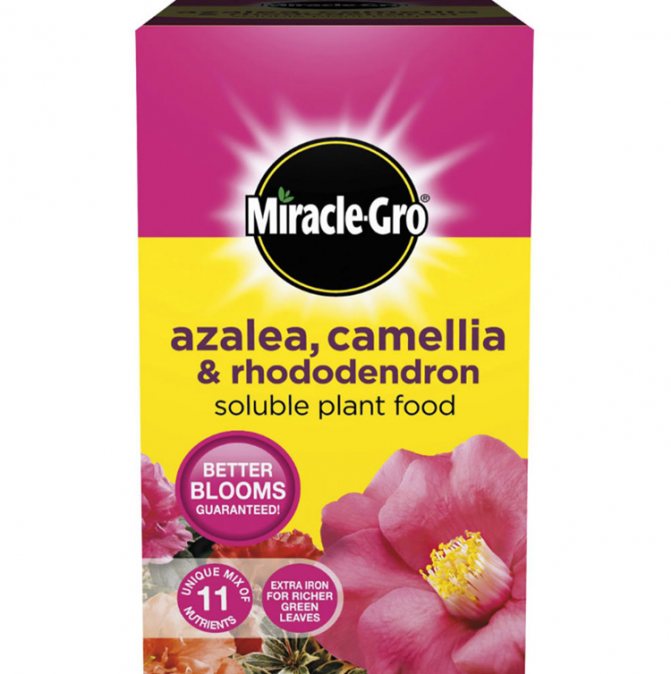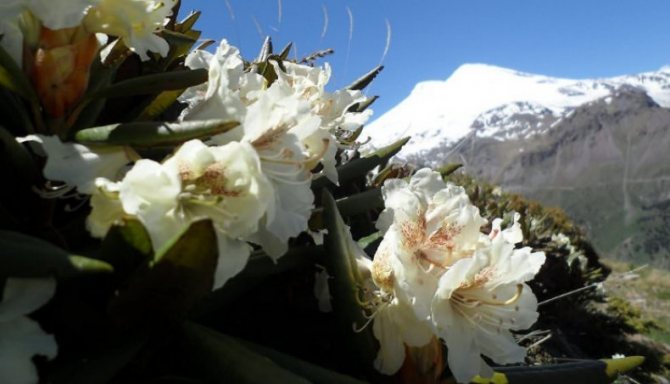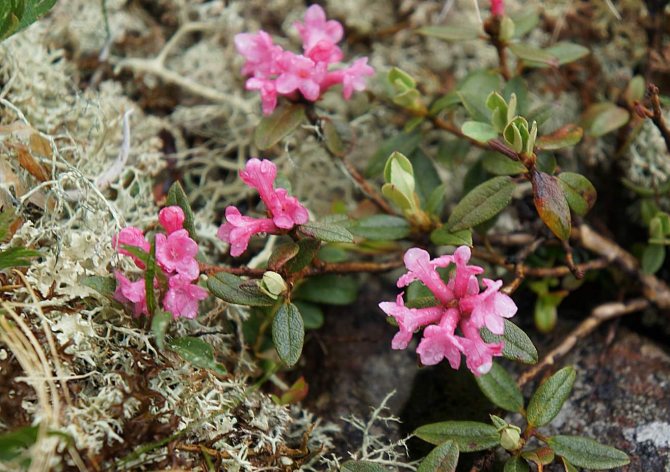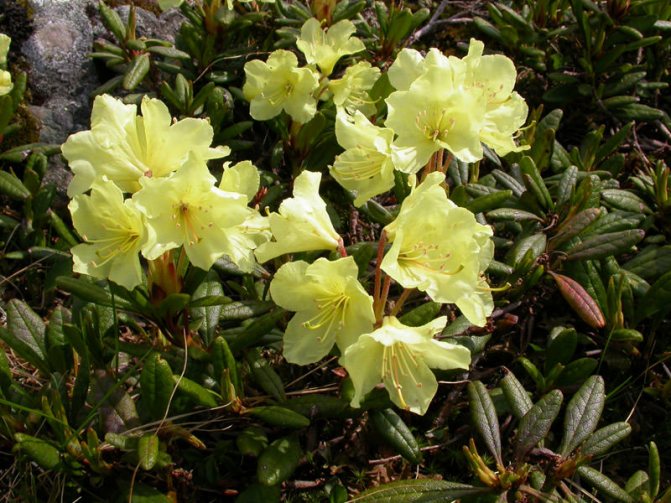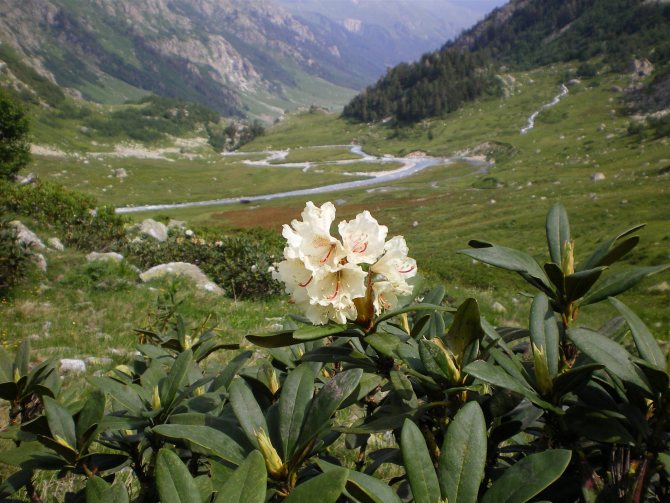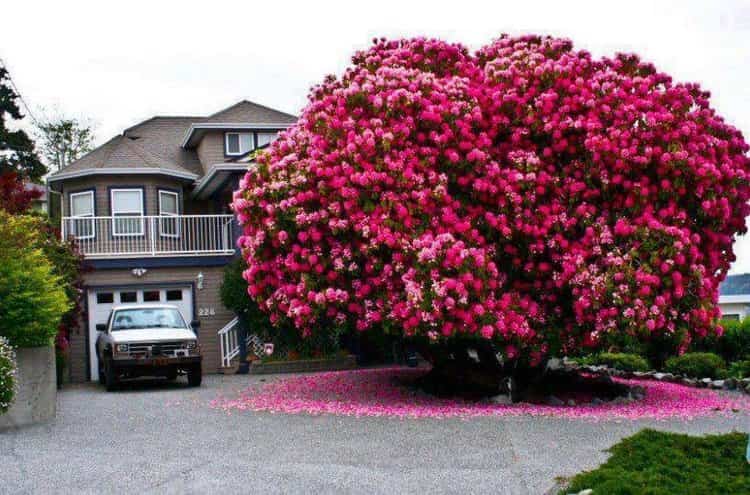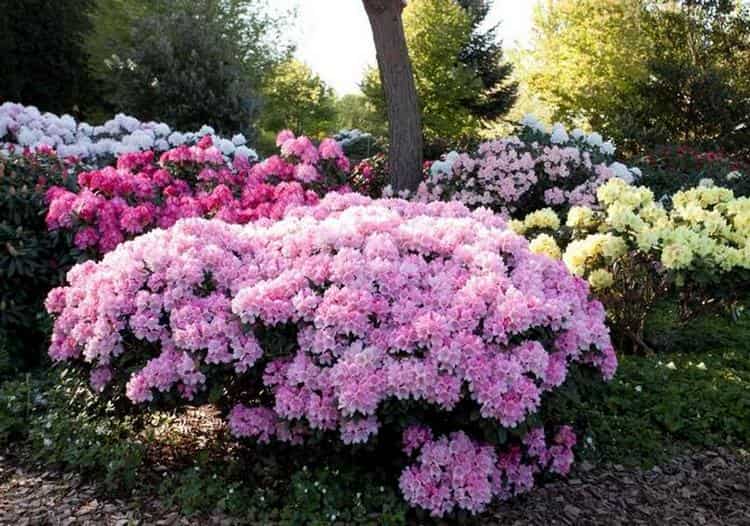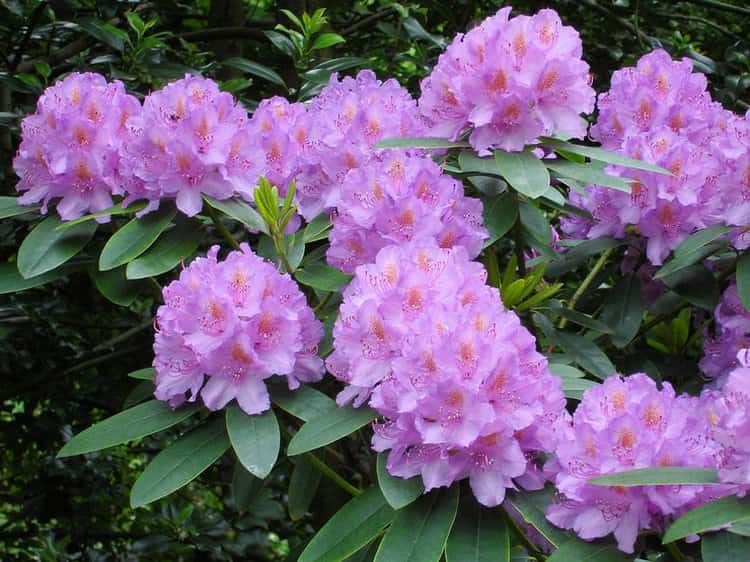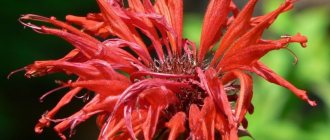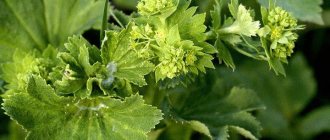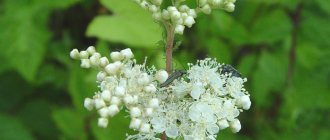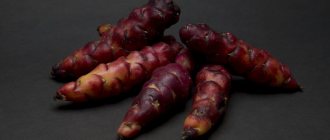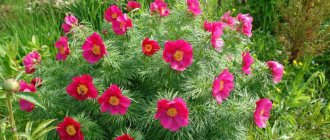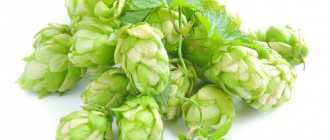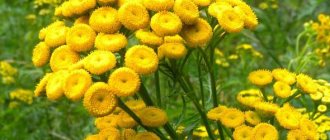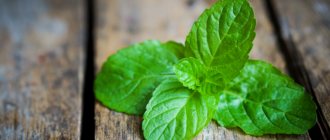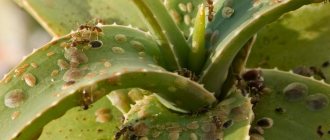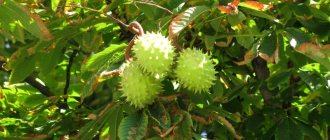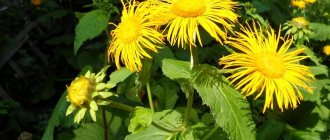Detailed description
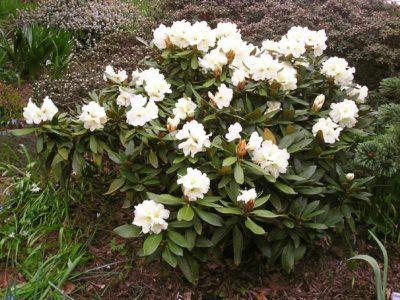
The Caucasian mountain rhododendron is a small evergreen shrub with spectacular leaves and gorgeous flowers that rival the beauty of the queen of flowers - the rose.
- Leaves they are thick and dense, on top they have a dark green glossy surface, and below it is grayish-green with an orange fluff, the shape of the leaves is elliptical, the tips are pointed.
- Escapes creeping, their bark is dark brown.
- Flowers - white, sometimes yellowish or cream; the shape of bells, collected in inflorescences of 10 - 15 pieces, the flowering period occurs at the beginning of summer: June - July.
- Root system - superficial, the roots grow in breadth.
About the benefits of rhododendron honey
Honey, made on the basis of the flowers of the Caucasian rhododendron, has since ancient times gained notoriety, since several cases of poisoning were noticed - people were delirious, they had hallucinations, and even deaths were observed in case of a severe overdose.
However, modern methods of obtaining honey made it possible to completely eliminate the risk of poisoning - honey from rhododendron has a characteristic beige hue, tart taste, which differs from the usual honey in that rhododendron honey is not so sweet. It is used in the treatment of colds, bronchitis, infectious diseases.
Those who have never tried this honey are advised to monitor the dose and not consume more than 2 tablespoons a day.
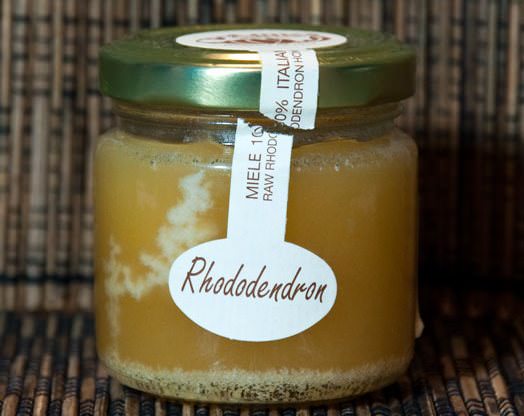

Healing properties
There are few such plants in our country where substances useful for humans are so concentrated, these are:
- essential oils;
- tannins;
- theanines;
- vitamin C;
- useful acids.
All parts of the plant have healing properties: stems, leaves, flowers and even roots. Many diseases are treated by Caucasian Rhododendron:
- joint diseases;
- hearts;
- kidneys;
- high blood pressure;
- purulent wounds;
- stomatitis and much more.
Then you can watch a video about the healing properties of the Caucasian rhodendron:
The most popular are medicinal teas and infusions of flowers and leaves.
Step-by-step instructions on how to make from leaves:
- tea - you need to take 4 dry leaves and pour two glasses of boiling milk, boil for 5 minutes strictly under the lid, you can take it at any time, but not more than three times a day;
- tincture - take 10 g of leaves (you can add the same amount of dried flowers) and pour one glass of vodka, remove to a dark place for 2 weeks, you can take 25 drops (be sure to dilute with water) 3 times a day.
Application of Caucasian rhododendron
In order for the Caucasian rhododendron to have a therapeutic effect, it is important to choose the right method of application. Most often, a decoction or alcohol tincture is prepared from the plant.
A decoction of the leaves normalizes the nervous system, relieves symptoms in diseases of bones and connective tissue. The course of admission is at least a month.
The procedure for preparing the broth:
- 5 g of dried leaves pour 1 liter of water.
- Bring the liquid to a boil for 5 to 8 minutes.
- Remove the container from the stove and leave the broth to infuse for 30 minutes.
The tool is taken three times a day, 50 ml. The broth is stored in the refrigerator. It is best to prepare a fresh product at least once a week.
Another way to use Caucasian rhododendron is tincture.They prepare it on their own or purchase a ready-made product in a pharmacy. The course of admission is from one to two months, after which they take a break for a month. The remedy lowers blood pressure and normalizes sleep.
Attention! Reception of the tincture should not exceed the dosage: the norm is no more than 25 drops per day.
Instructions for preparing the tincture:
- Measure 20 g of dry leaves and pour 200 ml of vodka into them.
- The mass is well mixed and kept in a place protected from sunlight.
- After 2 weeks, the agent is filtered.
- The resulting tincture is stored in a cool dark place.
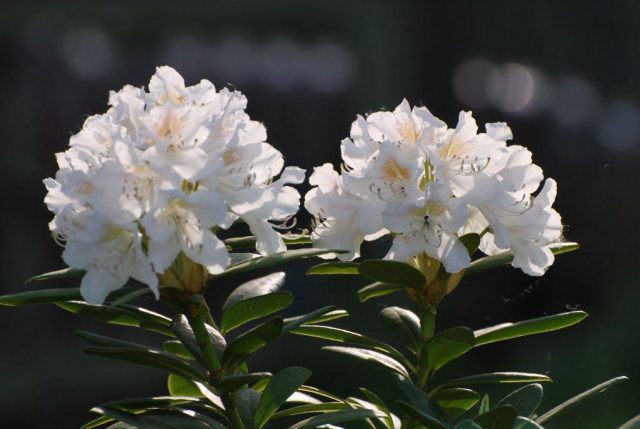

All sub-varieties and their photos
This species has several sub-varieties that differ in color. You can see their photos below.
Read also Flower spray champagne indoor care at home
Rosea-alba
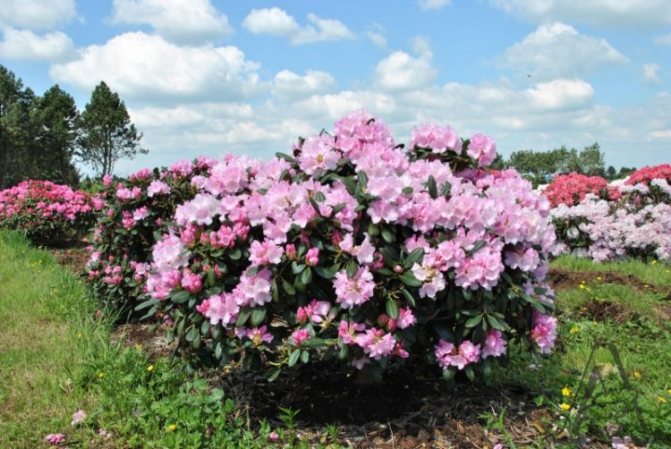

A shrub with flowers of a pale pink hue.
Splendens
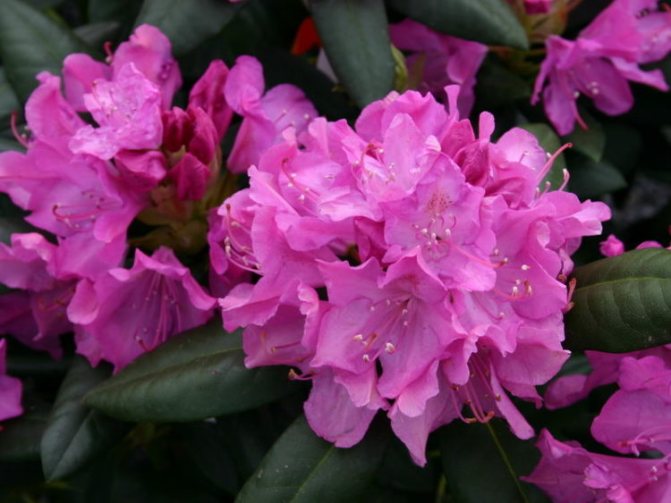

This variety has deep pink flowers.... They are collected in small inflorescences.
Flavidum
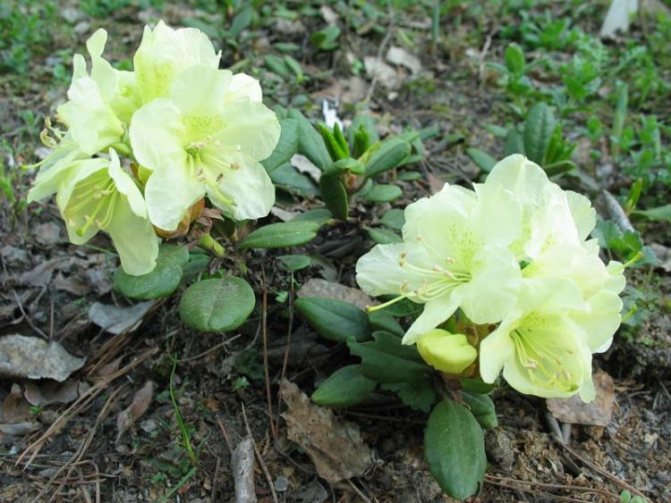

It has juicy yellow flowers.
How to brew healing rhododendron tea
To brew tea, you need to add no more than three or five leaves of a medicinal plant per one glass of drink. Thus, for the preparation of tonic tea, no more than 1 g of dry leaves of Caucasian rhododendron per 300 ml of boiling water should be added, which makes it possible to achieve a mild tonic effect when consumed. The drink is infused for about a quarter of an hour, after which it is filtered. It is very convenient to prepare a healing tea drink in a regular thermos. Important to remember,
that the maximum daily intake of such tea is no more than one glass.
To brew tea, you need to add no more than three or five leaves of Caucasian rhododendron per one glass of drink
Bloom
The peculiarity of the flowering of the Caucasian Rhododendron is that it occurs in summer, in June (other varieties bloom in early spring). Flowers are collected in umbrella-shaped inflorescences of 5 - 10 pieces.
How to care at this time?
- Before flowering, you need to carefully monitor the temperature so that the shrub does not suffer from late spring frosts, when the buds are already formed, top dressing just before flowering begins.
- If the weather is dry, be sure to water it.
- And after flowering, it is imperative to remove all flower stalks so as not to weaken the plant, otherwise the seeds will begin to ripen and also fertilize.
What if it does not give buds?
The reason may be in the wrong planting site (urgently transplant) or in a lack of moisture, you need to adjust the watering.
Methods for harvesting Caucasian rhododendron
In order for the plants to bring maximum benefit to the body, it is important to properly prepare the raw materials. Leaves are cut during the flowering period from shrubs over 2 years old. To do this, use sharp scissors or pruning shears. For work, choose the morning or evening period.
The collected leaves are dried outdoors or indoors. Be sure to choose a place in the shade, protected from direct sunlight. The collected raw materials are laid out on paper or a clean cloth. The leaves are kept until completely dry. The mass is stirred periodically.
When the raw material becomes more brittle and fragile, it is removed for storage. Dried leaves are kept at room temperature, protected from sunlight and high humidity. It is best to place the mass in a container and close the lid. The storage period is up to 2 years.
Step by step care instructions
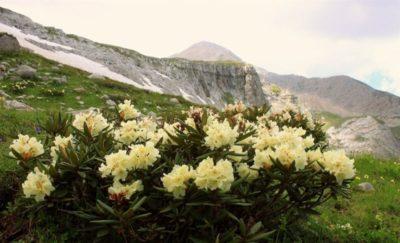

Choosing a landing site - this is a very important moment for the further growth and development of the shrub, because the plant is whimsical, loves sunny places, but not all day. The best place is under the diffused shade of a pine or larch, or under a barberry, and this place should not be blown by winds. It would be very nice to plant a bush next to a body of water - a pond, for example.- What should be the soil - it should be light, loose, breathable, groundwater should not rise high in it, should not be planted in lowlands.
- Landing - you need to plant a bush in spring, preferably in the second half of April. Drainage must be placed at the bottom of the planting pit, and then the plant is planted. After planting, be sure to make a near-trunk circle and water it well, and then mulch the surface.
- Temperature - This type of Rhododendron is frost-resistant, able to withstand frosts up to 20 degrees, and the maximum temperature for it is 25 degrees Celsius. The optimum temperature for good development is desirable in the range from -10 frost to 20 degrees Celsius. We wrote about frost-resistant rhododendrons here.
- Watering - shrubs need to be watered once a week in summer, less often in spring and autumn, depending on the weather. It is undesirable to water with tap water, it is best to use river or rainwater. Periodic spraying is also useful for the bush to create moisture.
- Top dressing - You will need to feed the shrub 3 times - at the beginning and end of flowering and at the very end of summer, you need to apply special balanced fertilizers for Rhododendrons, strictly according to the instructions.
- Pruning - for young bushes (which are 2 years old), pinching is required so that the crown is more magnificently formed, and for adult shrubs only sanitary pruning is required, which is carried out in the fall, while you can shorten all elongated shoots and remove excess ones.
- Transfer - if the bush needs to be transplanted, then it is best to do this in early spring, at the end of March or at the very beginning of April, but you can also transplant in the fall - in September, so that the plant has time to strengthen before winter.
- How to prepare for winter - Caucasian rhododendron needs shelter for the winter, for this you need to build arcs over the bush and pull lutrasil on them. You need to cover when the temperature begins to drop below 10 degrees below zero, and open in the spring when the soil warms up. And before the onset of frost, the bush needs to be watered well so that the roots are saturated with water.
Read also Heating with a water heater
Contraindications
Caucasian rhododendron is a very effective medicine for many diseases, therefore, like every medicine, it also has contraindications.
- It is forbidden to use drugs based on it for therapeutic purposes in the following conditions:
- pregnancy and lactation;
- chronic hypotension;
- individual intolerance causing an allergic reaction;
- tissue necrosis;
- a history of kidney disease.
And also these funds are contraindicated for children, as they contain toxic substances. For the same reason, they should be kept out of the reach of children.
Important! Some plant varieties contain andromedotoxin, a poisonous substance that acts as a sedative in small doses, so rhododendron-based preparations should be taken with caution and dosed correctly.
Caucasian rhododendron is not only a very beautiful shrub that adorns the mountain slopes, it is also incredibly healthy. The main thing in the use of his medicines is not to forget to consult a doctor, and also to take in the doses indicated in the instructions, taking into account all contraindications. Preparations from this plant are potent, so they should not be consumed uncontrollably.
Breeding features
This shrub can be propagated in a variety of ways.:
- Layers - Caucasian rhododendron reproduces very successfully by layers, they are easy to dig in, because they practically spread themselves along the ground. Layers are added in the spring, and a year later, next spring, the new plant can be separated and planted in another place.
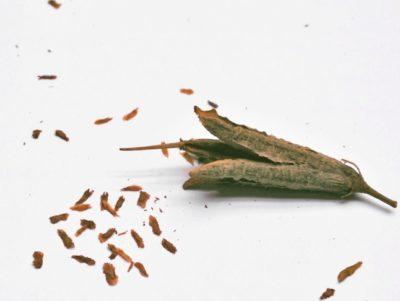

Seeds - you can also propagate it by seeds, this method is used for wild species.
- In August, we collect ripe seeds.
- We stratify them within 2 months, then soak them for 10 hours in Epin's solution.
- Next, we sow them into a substrate (do not deepen!), Prepared from peat with sand, create greenhouse conditions.
- After about 10 days (at a temperature of 20 degrees), seedlings appear. After 2 weeks, they can be unpacked.
- And after about a month, plant them in separate containers.
- In the spring we plant them in place, such bushes can bloom no earlier than 3 years later.
- Cuttings - at the beginning of summer, cuttings are cut (the length should be 15 cm), we root them in a light substrate and cover them with a jar on top, after 1.5 months they will already have their roots.
With what to plant a Caucasian rhododendron in a flower bed
The Caucasian rhododendron prefers damp, dark places. The plant is used in group and single plantings. Choose areas with wet soil. An excellent option is planting near water bodies and streams, under ornamental shrubs, spruces, pines and other trees. The plant will help fill the north side of the lot next to house walls and fences.
Rhododendrons planted in groups look spectacular. They are placed along lawns, paths and alleys. When planting, take into account the compatibility of colors. It is best to combine varieties with white, pink and purple inflorescences.
Beautiful tapeworm compositions are obtained from rhododendrons. The tall shrub stands out against the backdrop of the green lawn. The plant is also used to create rocky hills and hedges. Its combination with other alpine herbs is very effective.
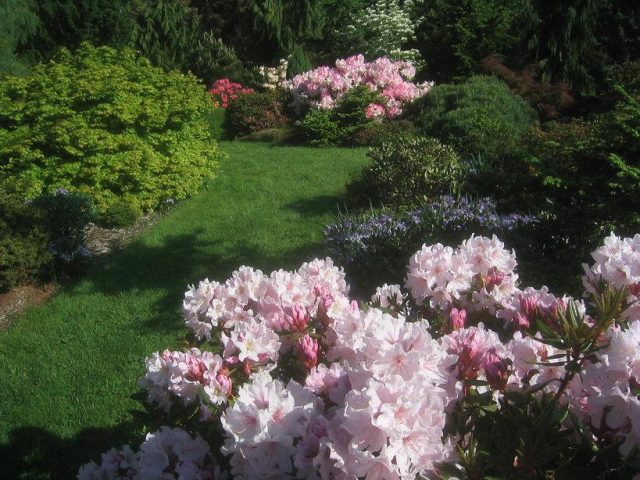

Botanical description [edit | edit code]
The Caucasian rhododendron reaches a height of 1-1.5 m. The stem is recumbent, with dark brown bark.
The leaves are oblong-oval, underneath covered with a dense short red felt.
Flowers are collected in an umbellate inflorescence, corolla up to 3 cm in length and in diameter, yellowish-white with green or reddish specks in the throat. The color of the corolla varies greatly from pure white (Mount Cho, Achishkho in the Western Caucasus) to pale cream or pale pink (Mount Gamzachiman in Northern Armenia, Mount Tskhra-Tskharo on the Trialeti Range). Pink-flowered forms are also found in the Elbrus region (Mount Cheget, Rhododendron caucasicum var.roseum).
Distribution and habitat [edit | edit code]
Endemic to the Caucasus, whose area covers the highlands of the Greater and Lesser Caucasus and enters Turkey along the Arsiyan and Lazistan ridges. Distributed at an altitude of 1600-3000 meters above sea level [4]. In Russia, it is found in Dagestan, North Ossetia, Chechnya, Ingushetia, Kabardino-Balkaria, Karachay-Cherkessia, in the mountains of the Krasnodar Territory and Adygea.
Read also: Crafts from the vine
This species is a representative of the mountain meadow subalpine landscape.
In culture [edit | edit code]
It has been known in culture since 1803, but it is quite rare, since it is difficult to cultivate [2].
In GBS since 1953, obtained by seedlings from Sochi. At the age of 15, the height is 0.75 m. Vegetation begins with the onset of above-zero temperatures. Shoot growth is noticeable from mid-May and ends in June. Secondary growth of shoots is observed in July-August. The average annual growth is 3-5 cm. It blooms in culture, as in nature, from 12 years old, from mid-May to early June. Secondary flowering is timed to mid-October, it happens not annually. Seeds rarely ripen in late October or early November. Winter-hardy in the presence of winter shelter. Winter hardiness without shelter II, in severe winters III. Poorly tolerates transplantation [6].
Introduced in Latvia at the beginning of the 20th century. Fully winter-hardy. It blooms and bears fruit annually. Grown in Riga, Jurmala, Talsa [2].
Withstands winter temperature drops down to -21 [3]. -29 ° C [7].
When it blooms in the mountains
The shrub begins to bloom in June, and blooms for about two months. In August, small seeds ripen in capsules. Since these very beautiful flowers grow high in the mountains, they are difficult to collect. Perhaps that is why rhododendron is valued both as an ornamental plant and as a medicinal plant.
Did you know? There is a legend that beautiful fragrant flowers were presented to the rhododendron by the elves, whom this plant sheltered for the night when they lost their home.
Plant care
A transplanted plant requires attention and careful care. In addition to regular abundant watering, the rhododendron needs spraying over the foliage, especially when planting in late spring. The soil needs to be mulched to maintain sufficient moisture. When mulching, you should choose options that increase the acidity of the soil.
The root system of rhododendrons consists of delicate, fine hairs, similar to matted hair, so loosening the soil, especially deep, should be excluded from flower care measures. Weeds growing next to the plant need to be removed periodically.
The appearance of the plant will immediately inform about the lack or excess of water - the leaves of the rhododendron will begin to turn yellow and fall off. Watering is required in sufficient quantities, but without overflow, this is one of the main rules for caring for a crop.
To ensure proper care of the rhododendron, it is important to timely prune the overgrown bushes. Places of cuts to prevent infection of the plant are covered with paint or garden varnish.
Compliance with simple plant care requirements will allow you to grow a wonderful flowering bush.
Rhododendron ponticum
We have already mentioned that this type of rhododendron, when crossed with the Caucasian one, gave a very popular white-flowered hybrid - Cunningham'sWhite. On its basis, hybrids with blue flowers “Blue Ensign”, “A. Bedford "," Blue Peter "," Anah Kruschke ".
The Pontic species is a melliferous plant, and its honey contains significant doses of andromedotoxin, which can lead to poisoning. Pets that eat plants are especially often poisoned. Although this species has many medicinal properties. Currently, they are insufficiently studied to be widely used.
Description
- An evergreen shrub that looks like a tree from 3 to 6 m.
- Leaves are short-petiolate, alternate up to 27 cm long, dense, oblong-elliptical, leathery, pointed, narrowed towards the base.
- It blooms from April to May, in the mountains from June to July.
- Flowers up to 6 cm wide, in umbellate inflorescences. The fruits are like five-leaf capsules.
Caucasian, Pontic and yellow rhododendrons are also united by the fact that all these species are famous for their medicinal properties, therefore they are used in folk medicine. Many gardeners would love to grow these plants in their garden. Unfortunately, the species described above do not grow well in culture, mainly their hybrids are grown.
We invite you to familiarize yourself with other materials on the topic of Rhododendrons:
What parts of the plant are you using?
In order to brew azalea tea, use:
- leaves;
- stems;
- flowers
Important! It is believed that the maximum concentration of nutrients in the rhododendron falls on 2-3 years of plant life.
Rhododendron leaves are more suitable for eliminating coughs caused by bronchitis, soothes the lungs and helps with asthma. And for tea, aimed at relieving headaches and sore throats, bush flowers are most often used.
What varieties are right?
Four rhododendrons have a pronounced healing effect:
- golden rhododendron;
- Caucasian rhododendron;
- rhododendron Adams;
- rhododendron daurian.
Rhododendron has a wide range of effects on the body:
Rhododendron products help with the following problems:
- diseases of the cardiovascular system;
- tachycardia;
- increased venous pressure;
- vegetative-vascular dystonia;
- cold;
- flu;
- epilepsy;
- migraine;
- insomnia;
- neuroses, irritability;
- diseases of the gastrointestinal tract;
- swelling;
- rheumatism;
- radiculitis;
- arthritis;
- gout;
- neuralgia;
- ulcers;
- boils;
- dermatitis;
- stomatitis;
- angina;
- various infections, including those caused by staphylococcus and streptococcus;
- intoxication;
- metabolic disease;
- diseases of the urinary system;
- disorders of memory and attention.
When using rhododendron products, it is very important to observe the exact dosage.
Important!
The plant contains a poisonous substance - the glycoside andromedotoxin, and therefore can bring not only benefits, but also harm.
Exceeding the dosage threatens with such unpleasant phenomena as:
- insomnia;
- hyperactivity;
- tachycardia;
- hallucinations;
- diarrhea;
- delayed separation of urine;
- impaired renal function.
You can learn more about the harmful and beneficial properties of Adams' rhododendron and other species of this plant.
The drink has a number of contraindications:
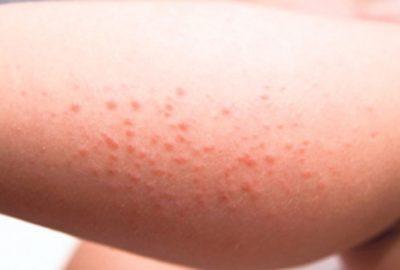

People suffering from chronic or severe illnesses should drink this tea with caution. The drink can cause side effects:
- dry mouth;
- dehydration;
- allergies.
Long-term use of tea leads to addiction of the body and a decrease in the therapeutic effect.
Note!
Before using rhododendron products, you should consult your doctor.
The benefits and harms of a medicinal plant
Our ancestors also used the snow rose, both for treatment and for the prevention of various diseases. This plant contains tannins, vitamins and trace elements. Also, rhododendron is famous for its high content of vitamin C, which helps fight viruses and enhances human immunity. Read more: Sage leaves: useful properties, contraindications, benefits and harms.
Read also Fertilizer nitrogen phosphorus potassium diammofosk
The medicinal plant has various properties that are beneficial for both the male and female body:
- Increases perspiration to rid the body of harmful substances by removing them with the help of sweat glands.
- Treats connective tissue diseases.
- It soothes and relaxes, which has a positive effect on the human nervous system.
- An excellent assistant during menopause, as it helps to normalize body temperature and eliminate its jumps.
- Helps cope with high fever by acting as an antipyretic agent.
- Removes excess cholesterol from the body.
- An excellent helper for those who want to lose weight, because rhododendron has the ability to burn fat.
- This plant is also good for use as a diuretic, to rid the body of excess fluid, for example, with edema.
- The bactericidal property that rhododendron possesses makes it possible to prevent the active growth and reproduction of bacteria, as well as lead to their death.
- Treats bone diseases.
- Helps fight pain during critical days.
- An excellent remedy for various degrees of poisoning, as it helps to remove toxins, toxins, heavy metals and other substances harmful to the human body from the body.
- It is an excellent helper in the treatment of infertility, due to the fact that it can fight inflammation in the uterus and its appendages.
- Treats cardiovascular disease.
- Helps in the elimination of inflammatory processes in the prostate gland.
However, despite the huge number of useful properties, rhododendron also contains one very harmful and dangerous compound - andromedotoxin, which is toxic and can harm the human body.
Therefore, when using a snow rose, you should adhere to the indicated dosage and not overdo it with the use of a medicinal plant. For the rest, it only has a positive effect on well-being and health, both for men and women.
What other herbs can you add to the mixture?
To make tea, rhododendron is combined with herbs such as:
- oregano;
- sage;
- thyme;
- St. John's wort;
- mint;
- echinacea;
- sweet clover;
- agrimony;
- lungwort;
- hawthorn flowers.
It is also helpful to add forest raspberries.
An excellent combination is a mixture of willow tea and rhododendron. This drink has a delicate aroma with hints of mountain meadows and the smell of the Siberian forest. Tea improves tone, promotes rejuvenation processes, improves metabolism, eliminates nervousness and fatigue.
Biochemical composition of wild rosemary
It is difficult to imagine a plant that will be as rich in essential oils, the concentration of which is found in the inner part of the leaves. Studies of their chemical composition have shown that germacron, farnesene, and nerolidol are located there. Along with the essential components, the shrub contains fatty acids: linolenic, oleic, ursolic, oleanolic. Quite recently it became known that sweet rosemary contains methyl alcohol and phenol.
Separately, it is worth noting the biochemical composition of each part of the shrub:
- Flavonoids can be found in rhododendron leaves - quercetin, rutin, dihydroquerticin, myricetin.
- Petals with leaves contain a large amount of vitamins C, D, the number of which increases with the flowering of the grass.
- Shoots are rich in acids, tannins, resinous substances, beta-sitosterol, andromedotoxin.
- Erikopin, which gives strength to the body, is found in all parts of this amazing plant.
The action of sagan-dail on the body
It is not for nothing that this shrub is called life-prolonging, because it has many useful properties:
- activates the work of all internal organs: brain, heart, lungs;
- improves the condition of blood vessels;
- removes harmful cholesterol, toxins, toxins from the body;
- reduces blood viscosity;
- relieves fatigue;
- helps with infections of a bacterial nature;
- stimulates the urinary system;
- prevents oxygen starvation;
- has a pronounced bactericidal, anti-inflammatory property;
- can have a detrimental effect on the pathogenic intestinal microflora;
- restores sleep;
- increases concentration of attention, enhances performance;
- has a beneficial effect on potency.
Homeopathic medicine rhododendron
When preparing a homeopathic remedy, golden rhododendron is used: fresh leaves and shoots with flower tops.
Indications for the use of Rhododendron to alleviate the condition of meteorological people:
- aching bones, joints;
- toothache;
- the appearance of edema;
- disorder of the digestive process;
- ear and eye diseases;
- health of women during menopause.
Arthritis pain is also treated with the homeopathic remedy Rhododendron. It not only eliminates pain, relieves nervousness, mental and physical strain.
Differences from other species
The main feature of the Caucasian Rhododendron is its pure white flowers, and it blooms twice a season - in early summer and in autumn - in October.
If you are interested in other types and varieties of rhododendron, we will tell you in detail about the following varieties: Helsinki University, Nap Hill, Fantasy, Yellow, Francesca, Japanese Geisha, Helliki, Roseum Elegance, Adams, Ledebour. They all fit perfectly into your garden design.
Sagan Daila in landscape design
Miraculous herb is used not only for medical or cosmetic purposes. Very often, the adams rhododendron can be found in personal plots.Experts recommend planting shrubs in a shaded area, away from the sun and plenty of water. Due to the fact that under natural conditions Sagan-grass grows in rocky terrain, it will have to prepare a special soil at the dacha.
In addition, the rhododendron is afraid of drafts. If there are pines, spruces or oaks in the country, then it is better to plant a plant in this area. You should not place the plant near other tall shrubs or flowers, due to its small growth, this amazing flower will be lost in their shade. The ideal option is to land Sagan near the curb, near the fence or along the edges of the path to the house.
What is useful and what heals
The rhododendron contains:
- tannins;
- flavonoids;
- rhododendrin;
- glycosides;
- ericoline;
- gallic acid;
- tranids;
- ursular acid;
- arbutin;
- essential oils;
- Sahara;
- tannins;
- rutin;
- vitamin C.
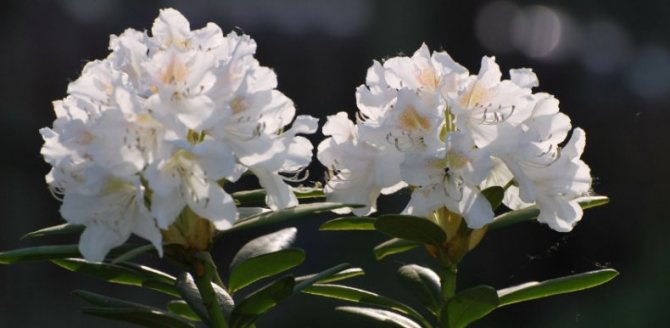

The listed components endow plants with the following qualities:
- bactericidal;
- antipyretic;
- calming;
- fat burning;
- diuretic and diaphoretic.
Thanks to these qualities, the dried parts of the bush are actively used in the treatment of:
- cardiovascular problems;
- viral infections;
- rheumatism;
- obesity;
- colitis;
- vegetative neuroses;
- female infertility;
- inflammatory processes in the pelvic organs in women;
- to remove toxins and heavy elements;
- to strengthen the immune system.
Fertilizing and feeding rhododendron
In the first year, the transplanted plants already require careful fertilization, which is applied in a highly diluted form, in small portions. The plant itself will signal the need for fertilization: it will stop growing, discard the foliage or the leaves change color, the formation of flower buds will stop.
Organic fertilizer for feeding rhododendron bushes - semi-decomposed manure, which must be infused in water. Top dressing is carried out with an aqueous solution of manure.
To increase the formation of flower buds, as well as to extend the flowering period, granular superphosphate, or double superphosphate, is used, which is scattered over the moist soil under the plants.
The plant is also useful for fertilizing with microelements, - fertilizers are applied in the form of watering or spraying the green mass of the bush. Intensive fertilization of the bushes is required until the end of August.
Description of rhododendron: varieties and varieties
The genus of rhododendrons is quite extensive - more than 1,000 species, which include various varieties of this wonderful plant.
Read also Everything for seedlings buy online store
The natural area of distribution of rhododendrons is limited to the eastern countries: China, Japan, Korea, the Himalayas; some plant species are found in the Caucasus, North America, northern Africa and Australia. In European territory, two varieties of rhododendron grow in the mountainous regions of Germany.
The culture refers to flowering deciduous or evergreen shrubs of the heather family. The branches of the plant can have smooth bark or pubescence. Leathery, dark green small ovoid leaves are sometimes pubescent.
Bell-shaped flowers, funnel-shaped, simple and double. The color of the petals varies depending on the variety: white, pink, lilac, red, purple. Modern varieties of rhododendron are yellow and orange in color. Numerous small seeds ripen in capsules.
Rhododendrons, the cultivation of which on the territory of Russia is most acceptable, is limited to 26 species belonging to three groups of plants.
- Evergreens are tall shrubs that do not shed their dark leathery foliage even in winter. Large flowers are painted in different colors and tones. Growing evergreen rhododendrons in the open field requires compliance with a number of necessary rules: plants are placed in places with diffused shadow; the soil for them should include a large amount of peat.
- Intermediate (semi-evergreen) - low shrubs that winter well under a layer of snow. The plant is characterized by a compact form, a huge number of flowers during the flowering period. In winter, most of the leathery leaves fall off, leaving only the whorl of leaves at the ends of the branches, from the center of which new foliage grows.
- Deciduous - rhododendrons of this group are most adapted to the conditions of the Russian climate. The cultivation of these plants is not difficult, and the plants themselves do not need to be specially adapted in winter. Blossoming in spring, repeated in autumn.
Diseases and pests
Fulfillment of the requirements for agricultural technology of rhododendrons guarantees excellent growth and development of plants. However, repeated waterlogging or overdrying of the soil, alkaline reaction of the soil, sunburn of leaves, can provoke an outbreak of crop diseases.
Plants can be damaged by spots, rust and chlorosis. Disease control measures - improving the conditions for keeping plants, the use of special means to combat diseases. Often, rhododendron diseases are caused by pathogenic fungi: gray rot, fusarium, late blight.
Pests that damage rhododendrons: slugs and snails that eat young leaves and buds. The collection of these pests is done manually. In addition, the plant is harmed by: bedbugs (rhododendron), spider mites, mealybugs, weevils, scale insects, rhododendra fly. Pest control is easy with systemic insecticides.
How to drink prepared drinks?
Tea should be drunk hot and fresh twice a day. It is permissible to consume no more than one glass per day.
The treatment course lasts from 14 to 30 days, then you need a break for two weeks. You should not drink this tea before bedtime - the drink tones up ..
During the period of taking funds on the basis, you must drink at least two liters of water per day.
Tea with rhododendron is not at all difficult to prepare. In the absence of contraindications in a person and compliance with the exact dosage such a drink will only benefit:
- strengthens the body;
- relieve fatigue;
- will increase the tone;
- will help in the fight against many ailments.
Many externally attractive plants also have hidden inner strength - many medicinal qualities. Such cultures are widely used in traditional medicine recipes to eliminate and prevent a variety of ailments. One of this type of plant is the rhododendron, which can be found in many parts of our planet, and even in the backyards of many amateur gardeners. One of the most famous medicinal varieties of this culture is the Caucasian rhododendron, the medicinal properties of which we will consider today, and also talk about the use, as well as brewing tea based on it.
Medicinal properties of Caucasian rhododendron
Caucasian rhododendron preparations have a remarkable bactericidal, antipyretic and diaphoretic effect. They also have soothing qualities and are able to relieve painful sensations.
Such a medicinal plant has a positive effect on the functioning of the cardiovascular system. The use of drugs based on it helps to eliminate excess fluids from tissues, neutralize shortness of breath, rapid heartbeat and swelling. In addition, such compounds activate the activity of the heart and help to establish the functioning of blood vessels.
Application of Caucasian rhododendron
Rhododendron leaves are often used in the treatment of rheumatism; they are also used to prepare medicinal compositions that eliminate the chronic form of colitis, colds and vegetative neurosis. These drugs can also be used to treat epilepsy. Remedies from rhododendron leaves treat bronchitis well, it is advisable to take them with a wet cough to accelerate the excretion of sputum.Such formulations have a calming effect on the lungs and relieve asthma by an order of magnitude.
Teas made from Caucasian rhododendron flowers eliminate sore throats and can be used to treat headaches.
Among other things, Caucasian rhododendron found application as a fairly effective bactericidal agent. So rhododendron is active against pathogenic microorganisms of the digestive tract, streptococci and staphylococci.
An infusion made from the color of this culture can be taken as a good sedative and hypnotic. Also, such a drink will help people with cardiovascular ailments, represented by myocarditis and pain in the region of the heart. The infusion will be useful for colds.
A decoction of rhododendron flowers is an effective remedy for many pathologies of the digestive tract. So it can be used to eliminate enteritis, gastroenteritis and gastritis. It is also advised to take it as a diuretic in the treatment of kidney stones.
Tincture based on rhododendron leaves and flowers is intended for external use. It should be rubbed into the affected area when correcting sciatica, neuralgia, as well as polyarthritis and osteochondrosis.
Homeopathic tincture of fresh leaves is used for poisoning with mercury vapor, in the treatment of gout and rheumatism. Also, this composition helps to cope with headaches, runny nose and diarrhea. It should be taken for urinary disorders and upper respiratory tract catarrh. Another internal reception of the tincture is indicated for the correction of heart failure.
To prepare an infusion based on rhododendron, you can combine a teaspoon of dried raw materials with a glass of only boiled water. Such a remedy should be insisted until completely cooled, then strain and consume a tablespoon three times a day. This version of the infusion copes well with insomnia, excessive irritability and seizures. It can also be taken to relieve headaches.
For the treatment of cardiovascular diseases, it is worth brewing two grams of dried and crushed raw materials with boiling water in the amount of one glass. Such a remedy should be insisted in a thermos for a couple of hours, then strain and consume a tablespoon twice or three times a day.
Such options for infusions also have a diuretic effect and can be used to rinse the mouth with sore throat, gum ailments, stomatitis and unpleasant odor.
Drink the traveler Caucasian rhododendron! How to brew tea
In ancient times, rhododendron tea was the original drink of the Circassians. Nowadays, it is not the first year that hunters in Siberia brew rhododendron leaves and drink like tea. They love that they give the drink a delicious flavor. Moreover, this tea is a stimulant and adaptogen in one person. To prepare such a highly beneficial drink, you only need four medium dried leaves of the plant, or 2 fresh leaves for one glass of water. Another classic tea recipe includes the use of milk (also in the amount of one glass), salt, cream and black pepper - to taste.
Dried leaves should be boiled with boiling water and boiled under a lid over a fire of minimum power for three to five minutes. The resulting broth must be insisted for another five to six minutes under the lid. Further, such a composition should be filtered and combined with milk, and then brought to a boil again.
Rhododendron tea was served hot, with salt, pepper and cream. However, you can try cooking it to your liking.
Such a drink is beneficial for a variety of heart ailments, reduced immunity and colds. Its consumption contributes to the normalization of blood circulation processes.So, in case of inflammatory lesions, it is recommended to drink tea from rhododendron shortly before a night's rest, after which it is worth wrapping up well to sweat overnight.
Please note that rhododendron can provoke allergies and should not be taken during pregnancy and lactation. It is important to observe the preparation of tea exactly, not to put more plant leaves in the teapot. The fact is that if the doses are observed, tea increases efficiency and tone, but in case of an overdose, it gives a delay in urine separation, disrupts kidney function, and also excites the nervous system. So be scrupulous and be healthy!
When you are advised to plant a Caucasian rhododendron, be careful because there is a little confusion with them. The fact is that several species are considered to be Caucasian, growing on the mountains of the same name at altitudes of more than 1200 m above sea level. And at the same time, there is a separate species with the same name. So, three varieties belong to the Caucasian rhododendrons: yellow, Caucasian and Pontic. This is what the article will talk about.
It is a shade-loving, frost-resistant plant. But in the shade, its shoots grow chaotically and vary greatly in length, so the bush may look untidy.
In the sun it forms a compact, even bush, but it does not bloom there. Rather, the buds appear, but dry out without having time to bloom. And if you find optimal lighting, it is possible to get an even bush with incredibly beautiful yellow flowers.
Its wonderful and strong scent can rival the very best floral scents. It is from the flowers that the azalea oil is obtained, which is used in perfumery to create perfumes.
Description
- Medium-sized deciduous shrub up to 2 m in height, less often up to 4. The crown can grow up to 2 m. Strongly branched and developed bush.
- During the year, it can grow by 5-8 cm. In the wild, the bush can live up to 100 years, in the garden less - about 50.
- The bark is light brown in color.
- The oblong-elliptical leaves up to 10 cm long, ciliate along the edge, look beautiful. Young leaves, first pubescent on both sides, then naked. In autumn they take on yellow, red and orange colors.
- The flowering period is from May to June. Duration of flowering is a little less than a month.
- Flowers from bright yellow to orange shades. They are small 1-2 cm and collected in inflorescences of more than 20 pieces! When the bush blooms, it is impossible to take your eyes off the abundant yellowness of the bush.

